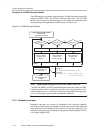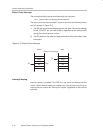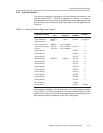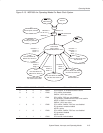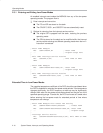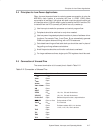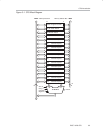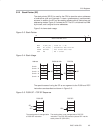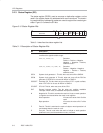
Principles for Low-Power Applications
2-17
System Resets, Interrupts, and Operating Modes
2.4 Principles for Low-Power Applications
Often, the most important factor for reducing power consumption is using the
MSP430’s clock system to maximize the time in LPM3. LPM3 power
consumption is less than 2 µA typical with both a real-time clock function and
all interrupts active. A 32-kHz watch crystal is used for the ACLK and the CPU
is clocked from the DCO (normally off) which has a 6-µs wake-up.
- Use interrupts to wake the processor and control program flow.
- Peripherals should be switched on only when needed.
- Use low-power integrated peripheral modules in place of software driven
functions. For example Timer_A and Timer_B can automatically generate
PWM and capture external timing, with no CPU resources.
- Calculated branching and fast table look-ups should be used in place of
flag polling and long software calculations.
- Avoid frequent subroutine and function calls due to overhead.
- For longer software routines, single-cycle CPU registers should be used.
2.5 Connection of Unused Pins
The correct termination of all unused pins is listed in Table 2−2.
Table 2−2.Connection of Unused Pins
Pin Potential Comment
AV
CC
DV
CC
AV
SS
DV
SS
V
REF+
Open
Ve
REF+
DV
SS
V
REF−
/Ve
REF−
DV
SS
XIN DV
CC
XOUT Open
XT2IN DV
SS
13x, 14x, 15x and 16x devices
XT2OUT Open 13x, 14x, 15x and 16x devices
Px.0 to Px.7 Open Switched to port function, output direction
RST
/NMI DV
CC
or V
CC
Pullup resistor 47 kΩ
Test/V
PP
DV
SS
P11x devices
Test DV
SS
Pulldown resistor 30K 11x1 devices
Open 11x1A, 11x2, 12x, 12x2 devices
TDO Open
TDI Open
TMS Open
TCK Open




